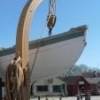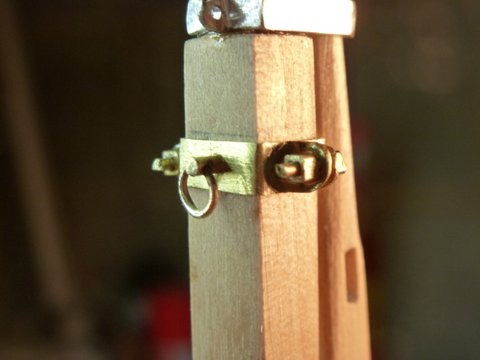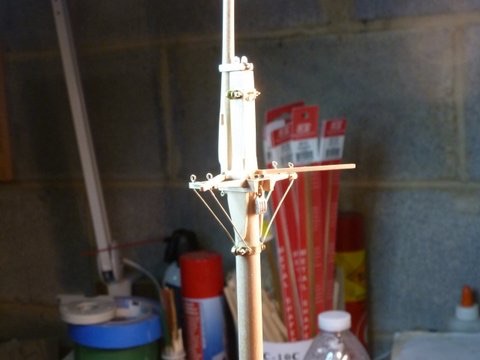-
Posts
449 -
Joined
-
Last visited
Content Type
Profiles
Forums
Gallery
Events
Everything posted by Landlocked123
-

Tool for Shaping Brass Strip
Landlocked123 replied to mikiek's topic in Metal Work, Soldering and Metal Fittings
I just give it a light going over with the steel brush wheel I'm my Dremel Best, John -

Tool for Shaping Brass Strip
Landlocked123 replied to mikiek's topic in Metal Work, Soldering and Metal Fittings
Mike, I strongly suggest you invest in a pair of quality parallel grip pliers with straight (not tapered) sides. For the brass work below, I annealed the brass as Mark suggested, scored the strip where I wanted the bend, inserted into the plier at 90* to the side, bent, and gave it a small tap with a hammer. I seem to recall that you can find the pliers for about $20. I use them constantly when working with metal. Best, John -
In the immortal words from "Trading Places".... "Looking good Billy Ray" Best, John Ps I wish all my friends on MSW a truly fabulous Christmas (with lots of tools under the tree). And the best of everything in the New Year!!!
-
Frankie, Remind me to never show you anything I build.
-

Dremel Versatip Butane soldering kit
Landlocked123 replied to riverboat's topic in Metal Work, Soldering and Metal Fittings
Frank, It really depends on whether you're "soft soldering" or silver soldering. There is a big difference. Depending on the solder, you will only need about +\- 500 degrees to made a joint with soft solder. Silver soldering is more like "brazing" and takes place +/- 1100 degrees. Once I learned silver soldering I rarely "soft" solder any more, I use it only were strength is not important as the high temps might be a problem. If you look around, there are plenty of "you tubes" to show techniques Best, John -
Picture please.
-
Julie, YIKES!!!!!! The idea of packing up 20+ years of accumulated stuff in my house, much less my workshop, gives the cold shivers and shakes. It makes me want to lock myself in my fly tying room with a half gallon of Johnny Walker. Your comment above regarding the possibility of the Liogier Very Tapered Rasp showiing on your doorstep has completely convinced me that you are an unabashed tool junkie in serious need of an intervention!
-
I get it now. Not much use for American boats from 1750 to 1890, but a good idea nonetheless. Best, John
- 396 replies
-
- Idea
- Bright Idea
-
(and 1 more)
Tagged with:
-
I get it now. Not much use for American boats from 1750 to 1890, but a good idea nonetheless. Best, John
- 396 replies
-
- Idea
- Bright Idea
-
(and 1 more)
Tagged with:
-
Dr. Slick fly tying scissors....that's all you need to know.
-
Hi Jules, As you know, I've been lurking around since your first posts on MSW. My only question is between building and posting when exactly do you sleep? Best, John
-

Harbor Freight Mini Wood Planes
Landlocked123 replied to grsjax's topic in Modeling tools and Workshop Equipment
Hi, I used the honing guide which came with my Veritas Sharpening System from Lee Valley for the three cheap planes from Harbour Freight. The blades are too small to fit normally, but the jig will hold them. I checked the sharpening angle by eye and took a black Sharpie to color the edge being sharpened. It only took a minute of adjusting until I was able to evenly remove the Sharpie in a pass or two. I used Japanese water stones 800 - 2000 and got an incredibly sharp edge. I also trued the sole, sides, and back of the blades. For $10.50 and a couple of hours work, I have three great planes. Best, John PS I I just spent a few minutes looking through the link above to the Sept. 1936 issue of Popular Science. It's great. There are quite a few references to model ship building including adds for ships and fittings. There is also an add for a circa 1936 Dremel Moto-tool. An amazing era when people built a lot of what they wanted. J. -
WOW Sal! You've really have turned into a Master. I can only hope to do half as well on my second build! Best, John
- 659 replies
-
- syren
- model shipways
-
(and 1 more)
Tagged with:
-
Hi Patrick, Following you logs through your various builds I'm beginning to feel like Gulliver in Lilliput!!!!!! Great work. Best, John
- 1,083 replies
-
Jazzchip, I completely understand your frustration. Following instructions which may say "nail the knibler to the wackadoodle" can be a real problem if you don't know what a hammer is, much less a knibler or wackadoodle! The arcane vocabulary doesn't help but somewhere I have a dictionary of terms which I downloaded and when I find it I will send you a PM with the location. But I stand by my earlier comments. Help is here if you ask. If you post pictures, so much the better. We've all been there. The learning curve is steep, but for me I have gotten incredible satisfaction from accomplishing small tasks which I never would've thought I could achieve. This can be an all encompassing and extremely gratifying endeavor. Like many of the best things in life you the more you put into it, the more you will get out of it (in multiples). Hang in there. Best, John
-
Jazzchip, Stick with your build. The most important thing you can do right now is to start a build log. You will get access to hundreds of great people who are willing help out with the questions that come up. I started building model ships after being fairly accomplished at building plastic models (mostly large scall Navy planes). I was caught a bit off guard when I opened my first model ship box saw a bunch of full scale plans, some instructions, and what looked like a pile of sticks. It was a far cry from glue piece A to piece B. Keep in mind that a great many models follow (at least some of) the practices of actual ship building and things may become more clear as you think them through. If you've not already done so, grab some introductory books. Frank Mastini's "Ship Modeling Simplified", Milton Roth's "Ship Modelling from Stem to Stern", and Ben Lankford's "How to Build First-Rate Ship Models from Kits" are ones I recommend and still refer to frequently. But again, I can't over emphasize the importance of staring a build log. It would probably be a good idea for to read through as many logs as possible especially ones which cover ships similar to the one you are currently building. Good luck.
-
Sal, Joe, and the rest of CMMS, I hope you all have a truly wonderful Thanksgiving! Best, John Ps Joe have a great time in China and don't eat anything too weird! J.
- 659 replies
-
- syren
- model shipways
-
(and 1 more)
Tagged with:
-
All I can say is WOW. For that matter it's worth saying again.......WOW!!!!!!!! Best, John
-

Power Precision Screwdriver
Landlocked123 replied to Julie Mo's topic in Modeling tools and Workshop Equipment
Hi Julie, I may be a tad late with this, but I spent a small fortune (actually way to small to be called any kind of fortune) buying all kinds of chucks, adapters, collets, etc for my Dremel and other rotary type tools and was never happy with the results. Every one had so much wobble that if you tried to drill a 0.020" hole I was lucky if it came out 0.040" before the bit broke. Also, the slowest speed my variable speed Dremel would go is something like 3000 rpm. Luckily, my brother retired from his jewelry business and gave me his Fordom tool. It's a bit expensive but with the foot pedal you can get it to go from 0-25,000+ rpm with no run out. If you look on Amazon and EBay you can find some good deals. Since your just building up your modeling tool collection, it's the way I would go first time around. Best, John -

THE 74-GUN SHIP by Jeronimo
Landlocked123 replied to Jeronimo's topic in - Build logs for subjects built 1751 - 1800
thanks- 194 replies
About us
Modelshipworld - Advancing Ship Modeling through Research
SSL Secured
Your security is important for us so this Website is SSL-Secured
NRG Mailing Address
Nautical Research Guild
237 South Lincoln Street
Westmont IL, 60559-1917
Model Ship World ® and the MSW logo are Registered Trademarks, and belong to the Nautical Research Guild (United States Patent and Trademark Office: No. 6,929,264 & No. 6,929,274, registered Dec. 20, 2022)
Helpful Links
About the NRG
If you enjoy building ship models that are historically accurate as well as beautiful, then The Nautical Research Guild (NRG) is just right for you.
The Guild is a non-profit educational organization whose mission is to “Advance Ship Modeling Through Research”. We provide support to our members in their efforts to raise the quality of their model ships.
The Nautical Research Guild has published our world-renowned quarterly magazine, The Nautical Research Journal, since 1955. The pages of the Journal are full of articles by accomplished ship modelers who show you how they create those exquisite details on their models, and by maritime historians who show you the correct details to build. The Journal is available in both print and digital editions. Go to the NRG web site (www.thenrg.org) to download a complimentary digital copy of the Journal. The NRG also publishes plan sets, books and compilations of back issues of the Journal and the former Ships in Scale and Model Ship Builder magazines.





